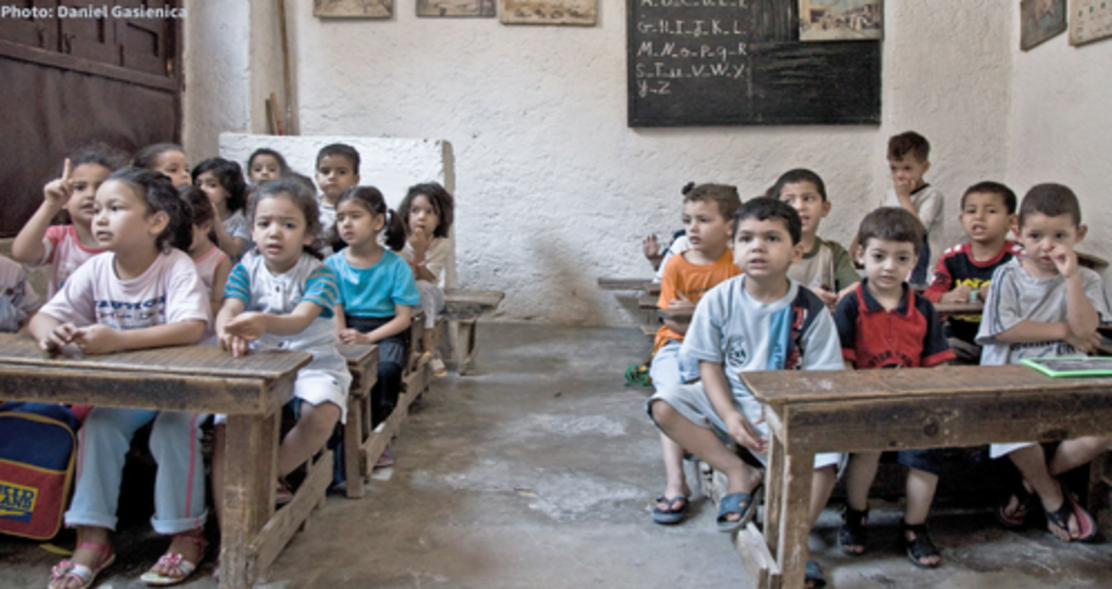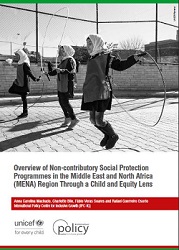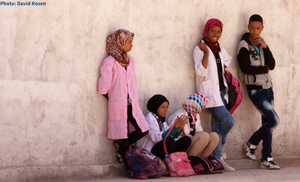New IPC-IG and UNICEF study maps the child sensitivity of non-contributory social protection programmes in the Middle East and North Africa
Providing both regional and country-level information, the report maps 185 non-contributory social protection programmes across 20 countries

By Denise Marinho dos Santos, Senior Communications Officer
Brasilia, 13 April 2018 – Child poverty is a major global development challenge. Children in developing countries are more than twice as likely as adults to live in extremely poor households. A recent study in 11 Arab countries has shown that one in four children—over 29 million—live in acute poverty. Against this background, social protection programmes can play an important role in tackling both in monetary and multidimensional poverty to improve children’s nutritional, health and education status.
Addressing this important topic of the development agenda, the International Policy Centre for Inclusive Growth (IPC-IG) and the UNICEF Middle East and North Africa Regional Office (MENARO) are glad to present an Overview of non-contributory social protection programmes in the Middle East and North Africa (MENA) region though a child and equity lens. This report assesses the state of child-sensitive design features of non-contributory social protection schemes in the MENA region, focusing on programmes implemented by national governments and that are at least partially financed by them. Providing both regional and country-level information, it maps 185 non-contributory social protection programmes across 20 countries: Algeria, Bahrain, Djibouti, Egypt, Iran, Iraq, Jordan, Kuwait, Lebanon, Libya, Morocco, Oman, Qatar, Saudi Arabia, Palestine, Sudan, Syria, Tunisia, United Arab Emirates, and Yemen. Additionally, under the scope of this project, the IPC-IG will be publishing a series of One Pagers, from May through December, featuring each of the 20 countries mapped and their child-sensitive social protection programmes. (see the end of the article)

The relatively large number of children in the region reinforces the importance of understanding and combating child poverty. Of the total estimated 467 million people living in MENA in 2016, 36.2 per cent were under the age of 18, and 11.6 per cent were under the age of five. Especially in countries in conflict, investing in children is paramount given the role they play in peace, development and social transformation while growing up.
Social protection in MENA is traditionally characterised by a reliance on universal food, fuel and utility subsidies and on contributory insurance schemes. However, there is growing consensus that non-targeted subsidies disproportionally favour the wealthy and have little effect on poverty reduction. Non-contributory social protection schemes, such as unconditional cash transfers, often target particularly vulnerable groups that are unable to work, resulting in low coverage of poor and vulnerable working families with children.
Little is known about the proportion of children covered by these programmes, but this information is crucial to enhance the child-sensitivity of social protection systems. The report investigates whether the mapped programmes have child-sensitive features in their design, looking at potential synergies with the health, nutrition and education sectors. Programmes are also classified as child-sensitive if they explicitly target children through at least one component, and if their benefits increase with the number of children in the household. A significant share of the programmes targeting children in the MENA region are for school-age children only, and very few explicitly target pre-school-age children.
Social protection programmes can enhance children’s access to education by directly incentivising school attendance through school feeding programmes or fee waivers, or by making the transfer conditional on school attendance. In the MENA region, all countries except Bahrain, Iraq and Syria have a non-contributory social protection programme classified as supporting access to education.
Regarding nutrition security, non-contributory social protection programmes can help tackle children’s malnutrition by improving the consumption levels of households through cash-based transfers or direct food transfers. Although more than half of all mapped countries have at least one programme supporting children’s access to nutrition, most of these programmes are for children attending school and exclude those who are out of school or at pre-school age. As children under 5 are particularly vulnerable to malnutrition, there is significant room for improvement.

Although health is one of the dimensions in which children of many countries in the region still face high levels of deprivation, access to health services appears to be an area in which the contribution of social protection programmes remains smaller compared to other areas. Non-contributory health insurance and health care benefits are the most prevalent programmes in improving the health status of children. In total, 8 of the 20 countries have programmes explicitly supporting children’s access to health. The report provides recommendations to governments, researchers and policymakers on how to contribute towards strengthening non-contributory social protection in MENA and making it more child-sensitive.
We present the serie of One Pagers featuring each of the 20 countries mapped in the original about the "Non-contributory social protection through a child and equity lens" sorted by language: Arabic, English, French and Portuguese.
Click here to download the full report in English (PDF); Read the Executive Summary in Arabic, English or French.